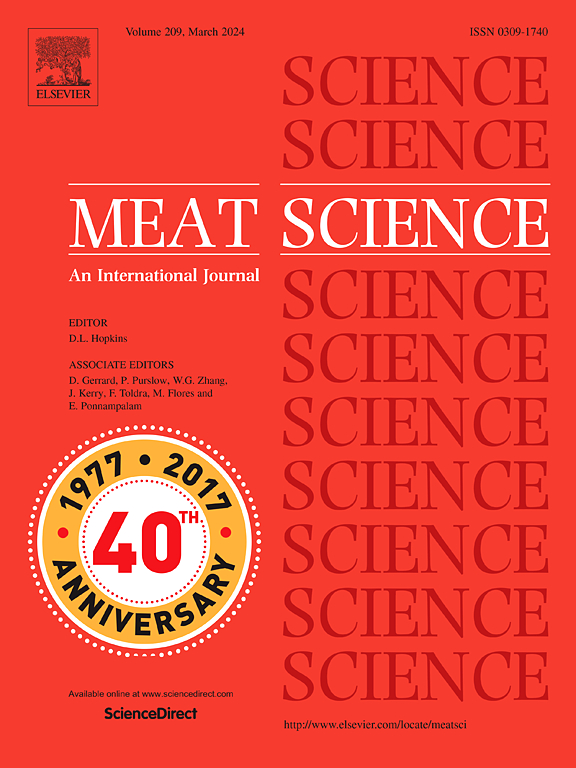Genotype and dietary inclusion of omega-3 fatty acids and fiber influence metabolism of subcutaneous adipose tissue and systemic metabolic outcomes in growing pigs
IF 7.1
1区 农林科学
Q1 Agricultural and Biological Sciences
引用次数: 0
Abstract
Adipose tissue properties are considered as determinants of meat quality, but also play roles in animal robustness. From 33 kg to 116 kg on average, a total of 60 Duroc (D) or Pietrain (P) crossbred female pigs were individually fed either a conventional (C) or an experimental (R) feeding strategy with a diet rich in omega 3 fatty acids and crude fibers (n = 15 pigs per group). The D pigs had a lower feed efficiency and a higher proportion of subcutaneous adipose tissue (SCAT) at slaughter than P pigs (P < 0.01). SCAT in D pigs had lower levels of polyunsaturated fatty acids (PUFA; P < 0.001) and higher levels of peroxidized lipids (P < 0.05) than SCAT in P pigs. In plasma, reactive oxygen metabolites to total antioxidant capacity was higher (P < 0.01) in D pigs than in P pigs. Compared to C, feeding the R diet resulted in a marked decrease in the n-6:n-3 PUFA ratio in SCAT, which was even more pronounced in D pigs than in P pigs (P < 0.05). The R feeding strategy increased beta-hydroxyacyl-coenzyme A dehydrogenase activity (P < 0.05) acting in fatty acid oxidation, and SCAT susceptibility to peroxidation. This also led to a reduction in plasma phospholipid concentrations and oxidative stress in the D pigs (P < 0.05). Thus, the nutritional value of fat products for humans and the systemic metabolic outcomes for pigs could be improved with an appropriate feeding strategy.
基因型和饲粮中omega-3脂肪酸和纤维的添加影响生长猪皮下脂肪组织的代谢和全身代谢结果
脂肪组织特性被认为是肉品质的决定因素,但也在动物健壮性中发挥作用。选取平均体重为33 ~ 116 kg的杜洛克(D)或皮特兰(P)杂交母猪60头,分别饲喂富含ω - 3脂肪酸和粗纤维的常规(C)和试验(R)饲粮(每组15头)。D组猪的饲料效率低于P组猪,屠宰时皮下脂肪组织(SCAT)比例高于P组猪(P <;0.01)。D型猪SCAT中多不饱和脂肪酸(PUFA)水平较低;P & lt;0.001)和更高水平的过氧化脂质(P <;0.05)高于SCAT。血浆中活性氧代谢产物占总抗氧化能力的比例较高(P <;0.01)。与C组相比,R组饲粮显著降低了猪SCAT中n-6:n-3 PUFA比例,D组比P组更明显(P <;0.05)。R饲喂策略增加了β -羟酰基辅酶A脱氢酶活性(P <;0.05)脂肪酸氧化作用,以及SCAT对过氧化的敏感性。这也导致D组猪血浆磷脂浓度和氧化应激降低(P <;0.05)。因此,通过适当的饲养策略,可以提高脂肪产品对人类的营养价值和猪的全身代谢结果。
本文章由计算机程序翻译,如有差异,请以英文原文为准。
求助全文
约1分钟内获得全文
求助全文
来源期刊

Meat Science
工程技术-食品科技
CiteScore
12.60
自引率
9.90%
发文量
282
审稿时长
60 days
期刊介绍:
The aim of Meat Science is to serve as a suitable platform for the dissemination of interdisciplinary and international knowledge on all factors influencing the properties of meat. While the journal primarily focuses on the flesh of mammals, contributions related to poultry will be considered if they enhance the overall understanding of the relationship between muscle nature and meat quality post mortem. Additionally, papers on large birds (e.g., emus, ostriches) as well as wild-captured mammals and crocodiles will be welcomed.
 求助内容:
求助内容: 应助结果提醒方式:
应助结果提醒方式:


